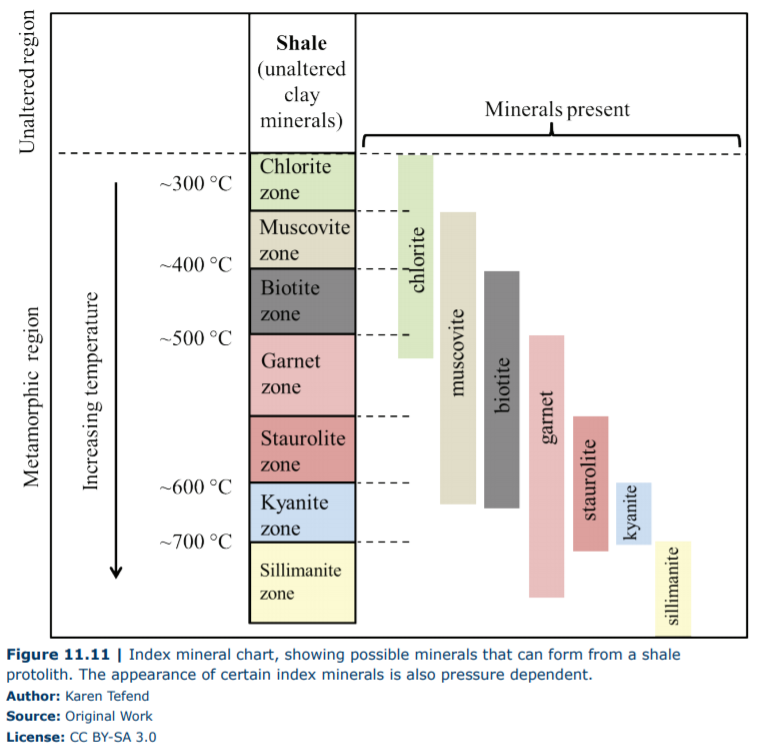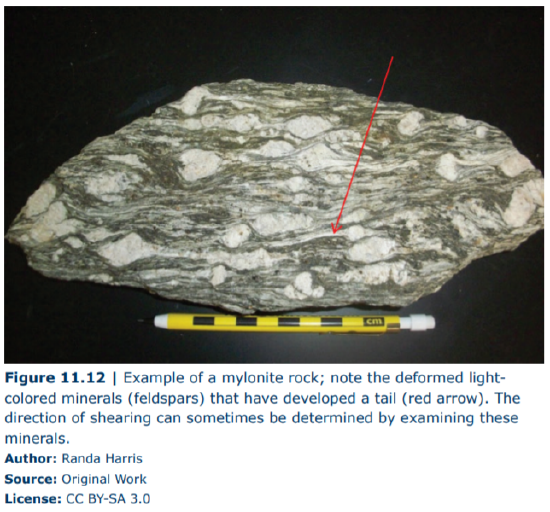11.5: Types of Metamorphism
- Page ID
- 5667
\( \newcommand{\vecs}[1]{\overset { \scriptstyle \rightharpoonup} {\mathbf{#1}} } \)
\( \newcommand{\vecd}[1]{\overset{-\!-\!\rightharpoonup}{\vphantom{a}\smash {#1}}} \)
\( \newcommand{\id}{\mathrm{id}}\) \( \newcommand{\Span}{\mathrm{span}}\)
( \newcommand{\kernel}{\mathrm{null}\,}\) \( \newcommand{\range}{\mathrm{range}\,}\)
\( \newcommand{\RealPart}{\mathrm{Re}}\) \( \newcommand{\ImaginaryPart}{\mathrm{Im}}\)
\( \newcommand{\Argument}{\mathrm{Arg}}\) \( \newcommand{\norm}[1]{\| #1 \|}\)
\( \newcommand{\inner}[2]{\langle #1, #2 \rangle}\)
\( \newcommand{\Span}{\mathrm{span}}\)
\( \newcommand{\id}{\mathrm{id}}\)
\( \newcommand{\Span}{\mathrm{span}}\)
\( \newcommand{\kernel}{\mathrm{null}\,}\)
\( \newcommand{\range}{\mathrm{range}\,}\)
\( \newcommand{\RealPart}{\mathrm{Re}}\)
\( \newcommand{\ImaginaryPart}{\mathrm{Im}}\)
\( \newcommand{\Argument}{\mathrm{Arg}}\)
\( \newcommand{\norm}[1]{\| #1 \|}\)
\( \newcommand{\inner}[2]{\langle #1, #2 \rangle}\)
\( \newcommand{\Span}{\mathrm{span}}\) \( \newcommand{\AA}{\unicode[.8,0]{x212B}}\)
\( \newcommand{\vectorA}[1]{\vec{#1}} % arrow\)
\( \newcommand{\vectorAt}[1]{\vec{\text{#1}}} % arrow\)
\( \newcommand{\vectorB}[1]{\overset { \scriptstyle \rightharpoonup} {\mathbf{#1}} } \)
\( \newcommand{\vectorC}[1]{\textbf{#1}} \)
\( \newcommand{\vectorD}[1]{\overrightarrow{#1}} \)
\( \newcommand{\vectorDt}[1]{\overrightarrow{\text{#1}}} \)
\( \newcommand{\vectE}[1]{\overset{-\!-\!\rightharpoonup}{\vphantom{a}\smash{\mathbf {#1}}}} \)
\( \newcommand{\vecs}[1]{\overset { \scriptstyle \rightharpoonup} {\mathbf{#1}} } \)
\( \newcommand{\vecd}[1]{\overset{-\!-\!\rightharpoonup}{\vphantom{a}\smash {#1}}} \)
\(\newcommand{\avec}{\mathbf a}\) \(\newcommand{\bvec}{\mathbf b}\) \(\newcommand{\cvec}{\mathbf c}\) \(\newcommand{\dvec}{\mathbf d}\) \(\newcommand{\dtil}{\widetilde{\mathbf d}}\) \(\newcommand{\evec}{\mathbf e}\) \(\newcommand{\fvec}{\mathbf f}\) \(\newcommand{\nvec}{\mathbf n}\) \(\newcommand{\pvec}{\mathbf p}\) \(\newcommand{\qvec}{\mathbf q}\) \(\newcommand{\svec}{\mathbf s}\) \(\newcommand{\tvec}{\mathbf t}\) \(\newcommand{\uvec}{\mathbf u}\) \(\newcommand{\vvec}{\mathbf v}\) \(\newcommand{\wvec}{\mathbf w}\) \(\newcommand{\xvec}{\mathbf x}\) \(\newcommand{\yvec}{\mathbf y}\) \(\newcommand{\zvec}{\mathbf z}\) \(\newcommand{\rvec}{\mathbf r}\) \(\newcommand{\mvec}{\mathbf m}\) \(\newcommand{\zerovec}{\mathbf 0}\) \(\newcommand{\onevec}{\mathbf 1}\) \(\newcommand{\real}{\mathbb R}\) \(\newcommand{\twovec}[2]{\left[\begin{array}{r}#1 \\ #2 \end{array}\right]}\) \(\newcommand{\ctwovec}[2]{\left[\begin{array}{c}#1 \\ #2 \end{array}\right]}\) \(\newcommand{\threevec}[3]{\left[\begin{array}{r}#1 \\ #2 \\ #3 \end{array}\right]}\) \(\newcommand{\cthreevec}[3]{\left[\begin{array}{c}#1 \\ #2 \\ #3 \end{array}\right]}\) \(\newcommand{\fourvec}[4]{\left[\begin{array}{r}#1 \\ #2 \\ #3 \\ #4 \end{array}\right]}\) \(\newcommand{\cfourvec}[4]{\left[\begin{array}{c}#1 \\ #2 \\ #3 \\ #4 \end{array}\right]}\) \(\newcommand{\fivevec}[5]{\left[\begin{array}{r}#1 \\ #2 \\ #3 \\ #4 \\ #5 \\ \end{array}\right]}\) \(\newcommand{\cfivevec}[5]{\left[\begin{array}{c}#1 \\ #2 \\ #3 \\ #4 \\ #5 \\ \end{array}\right]}\) \(\newcommand{\mattwo}[4]{\left[\begin{array}{rr}#1 \amp #2 \\ #3 \amp #4 \\ \end{array}\right]}\) \(\newcommand{\laspan}[1]{\text{Span}\{#1\}}\) \(\newcommand{\bcal}{\cal B}\) \(\newcommand{\ccal}{\cal C}\) \(\newcommand{\scal}{\cal S}\) \(\newcommand{\wcal}{\cal W}\) \(\newcommand{\ecal}{\cal E}\) \(\newcommand{\coords}[2]{\left\{#1\right\}_{#2}}\) \(\newcommand{\gray}[1]{\color{gray}{#1}}\) \(\newcommand{\lgray}[1]{\color{lightgray}{#1}}\) \(\newcommand{\rank}{\operatorname{rank}}\) \(\newcommand{\row}{\text{Row}}\) \(\newcommand{\col}{\text{Col}}\) \(\renewcommand{\row}{\text{Row}}\) \(\newcommand{\nul}{\text{Nul}}\) \(\newcommand{\var}{\text{Var}}\) \(\newcommand{\corr}{\text{corr}}\) \(\newcommand{\len}[1]{\left|#1\right|}\) \(\newcommand{\bbar}{\overline{\bvec}}\) \(\newcommand{\bhat}{\widehat{\bvec}}\) \(\newcommand{\bperp}{\bvec^\perp}\) \(\newcommand{\xhat}{\widehat{\xvec}}\) \(\newcommand{\vhat}{\widehat{\vvec}}\) \(\newcommand{\uhat}{\widehat{\uvec}}\) \(\newcommand{\what}{\widehat{\wvec}}\) \(\newcommand{\Sighat}{\widehat{\Sigma}}\) \(\newcommand{\lt}{<}\) \(\newcommand{\gt}{>}\) \(\newcommand{\amp}{&}\) \(\definecolor{fillinmathshade}{gray}{0.9}\)Regional Metamorphism
Metamorphism that affects entire rock bodies over a broad region is referred to as regional metamorphism. There is a wide range of conditions in temperature and pressure that produce a wide range of metamorphic rock types. For example, all of the foliated rocks fall into this metamorphic category and some non-foliated rocks as well. The main point is that a large area is affected by changes in temperature and/or pressure. One type of regional metamorphism occurs at convergent plate boundaries, where rocks are subjected to a variety of pressures and temperatures, resulting in thermodynamic metamorphism (“thermo-” for increased temperature, and “dynamic” for increased pressure). Mountain ranges that form by the converging of tectonic plates are classic examples of thermodynamic metamorphism, such as the Himalayan Mountains located in Asia or our Sierra Nevada Mountains in North America. These can be viewed if you type the mountain range name in the search bar in Google Earth. Regional metamorphism also occurs along plate boundaries where an oceanic plate descends (subducts) back into the mantle as a result of plate convergence (this was discussed in the plate tectonics chapter); oceanic plates that subduct into the mantle will form a deep ocean trench, such as the trench along the western margin of South America. With increased pressure in these regions, metamorphic foliations can get quite pronounced, as we saw in the development of slate to schist to gneiss. With increased temperature, we see increases in grain size as well as the introduction of new minerals in the metamorphosed rock. These new minerals are useful in that they define the temperature of metamorphism for both regional and contact metamorphism (next section).
Figure 11.11 is an example of the possible index minerals that form during the metamorphism of a shale protolith. Shale is a sedimentary rock that contains clay minerals and clay-sized quartz and (sometimes) feldspars. With increased temperature, recrystallization involves the formation of new minerals, starting with chlorite at the lowest metamorphic temperature. High-temperature metamorphism results in the formation of the mineral sillimanite. The metamorphic sections in this figure are called mineral zones, named for the appearance of each new mineral. For example, the garnet zone begins when garnet first appears in the rock, and the appearance of a new mineral, staurolite, marks the end of the garnet zone and the beginning of the staurolite zone. The study of such index mineral zones has importance in terms of economic exploration, as some of these index minerals have economic importance. For example, garnet is used as an abrasive, and sometimes for decorative purposes as a gemstone.

Contact Metamorphism
As mentioned previously, recrystallization due to increased temperature results in the formation of larger minerals, or sometimes in the formation of new minerals (Figure 11.11). Contact metamorphism describes the type of metamorphism attributed to increased temperature, usually from proximity to a heat source such as an intrusive magma body or a lava flow, and the rock undergoes thermal metamorphism. The rocks that are in closer contact to the magma will form larger crystals due to the higher heat and may form high-temperature index minerals such as garnet, staurolite, kyanite, and sillimanite. Rocks that are in contact with hot chemically reactive fluids can also fall within the contact metamorphism category; recrystallization due to this type of contact is called hydrothermal metamorphism. Unlike the regional metamorphism described in the previous section, both types of contact metamorphism are confided to smaller areas near the heat source (magma, lava, or hydrothermal fluids). Since differential pressures are not involved, contact metamorphism results in the formation of non-foliated rocks. The non-foliated rock types that were covered previously included marble, quartzite, amphibolite, and anthracite coal. Other non-foliated rocks that have undergone contact metamorphism are broadly classified as hornfels or granofels to indicate that they are recrystallized rocks that lack foliation. For example, shale can be altered into a hornfels if it is recrystallized but lacks slaty cleavage due to the lack of any developed foliation.
Shock (Impact) Metamorphism
This type of metamorphism is not as common as regional or contact metamorphism, and it differs from the other types in a spectacular way. Regional and contact metamorphism requires quite a bit of time (up to several hundred thousand years) for rocks to metamorphose; shock metamorphism takes place in a matter of seconds. This type of metamorphism occurs at the site of meteorite craters; rocks at the surface and near-surface are subjected to extreme stresses upon impact, and sometimes portions of these surface rocks become tiny blobs of melt that cool to form a type of glass called a tektite. Age dating of these tektites has helped in the determination and even recognition of ancient meteorite impact sites worldwide. Shock or impact metamorphism is mainly due to the extreme stresses brought on by the impact and, for this reason, shock metamorphism is considered to be a dynamic metamorphism, as opposed to dynamothermal (regional) metamorphism.
Fault Zone Metamorphism
Rocks along geologic faults are deformed due to pressures associated with shearing, compression, or extensional stresses, with minor changes due to heat. As with shock metamorphism, fault zone metamorphism is a type of dynamic metamorphism. Shallow faults (close to the earth’s surface) may grind the nearby rocks into smaller, angular fragments called fault breccia, or you may see a fine clay powder called fault gouge; fault gouge forms by the chemical alteration of fault breccia. Fault breccia is a form of brittle deformation of rock; at greater depths, rocks along a fault will undergo a more plastic-type of deformation. The rocks that form adjacent to the fault in deeper sections are called mylonite (Figure 11.12). The minerals in mylonitic rocks are deformed due to shear stresses associated with movement along the fault.



